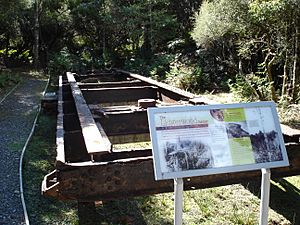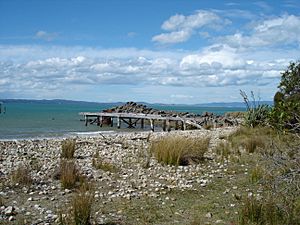Port Craig facts for kids
Port Craig is a historic place found on the south coast of New Zealand's South Island, near a bay called Te Waewae Bay and the town of Tuatapere. It used to be a busy logging town, which means it was built around the business of cutting down trees for wood.
The town started in 1916. At its busiest, over 200 people lived there, including men, women, and children. These people were often tough New Zealanders, called kiwi bushmen, and new immigrants.
A company called Marlborough Timber had big plans to cut down trees in one of New Zealand's last large coastal forests. They built a huge sawmill, which is a factory for cutting timber. They also created a wide network of tracks for trains (called a tramway) and a port for ships. All of this was built without any roads leading to the town!
The loggers used a massive machine called a Lidgerwood overhead logging cable system, also known as a gantry. This machine weighed more than 50 tonnes. Because it was so big, it was very hard to move through the thick forest. After one big move, the gantry was left behind, and this made it very difficult for the logging business to continue.
Today, Port Craig is a ghost town, but you can still see many old things left behind. These include parts of the gantry machine, a large English-built winch that was used on the wharf, and thousands of old bricks. You can also find a mostly complete baker's oven and the original school building. The old school is now used as a hut for people who are hiking.
Contents
History of Port Craig
Whaling and Early Tracks
Long ago, in 1877, there was a whaling station at Mussel Beach, which is near Port Craig. Whaling stations were places where whales were processed after being caught.
Later, in 1908, a track from Bluecliffs to Puysegur Point was made better when a phone line was put in. The first main camp for this work was at Mussel Beach. Special cages were built to help people cross the big rivers. The track was improved even more in 1919 and 1920, becoming a horse track that went all the way from Bluecliffs to Port Craig.
Logging Operations
The main logging work at Port Craig began in 1917. It continued for about 12 years until 1929, when the town had to close down. This happened because of a big economic problem called the Great Depression, which made it hard for businesses to keep going.
The Port Craig Tramway
Work on the Port Craig tramway started in 1917. This was a special railway with a track width of 3 feet 6 inches, which is the standard size for railways in New Zealand. The tramway ran south from Port Craig, following the coast for about 14.6 kilometers (about 9 miles) to the Wairaurāhiri River. There were also other smaller tracks that branched off for another 9.8 kilometers (about 6 miles).
By 1921, the main line stretched over a mile from the sawmill, and it was made even longer in 1924. Steam locomotives, which are trains powered by steam, started using the line in 1919. One of these was a very large bush locomotive built by A & G Price. This special train, called a Meyer type Ar, was used on the line from 1926 to 1931. The metal rails of the tramway were removed in 1939.
Nature and Wildlife
Port Craig is far away from big towns, which means the natural environment around it is still very beautiful. Sometimes, you can see amazing sea creatures like Southern right whales and Hector's dolphins playing close to the shore.
However, not all changes to nature have been good. As early as 1896, people noticed that ferrets, which are small animals brought to New Zealand, seemed to have caused the disappearance of native birds like wekas and kākāpō as far west as the Waitutu River.
Walking Tracks Today
Today, parts of the old tramway have been cleared and turned into walking paths. In 2009, these paths became part of the Hump Ridge and South Coast Tracks, which are popular routes for hikers. The old school building in Port Craig is now used as a hut where hikers can stay overnight.



